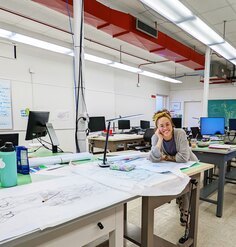Olmsted Scholar Feature: Waste Landscapes
By Caitlin Harrigan, 2010 National Olmsted Scholar Finalist
Simultaneously fascinating and repelling, waste landscapes reveal much about the ways in which we order and respond to our environments, and how we will evolve with those environments in the future. I believe that landscape architects have much to offer to the design of waste landscapes. By shaping these typically marginalized places in an ecologically revealing way, we can begin to unveil and recognize the destructive effects of our consumptive lifestyles. But more importantly, we can create spaces that inspire people to contemplate and recognize the value of environmental quality as well as the development of strategies that enhance ecological function. As places that facilitate meaningful human interaction and activity focused on recycling, waste and reuse operations can galvanize a group of people around a common cause. They can help facilitate the paradigm shift from mindless consumption to thoughtful conservation. There is immense potential for waste places to act as local rallying points – spaces that remind us that there is such a thing as enough.
As a graduate student, I studied the intersection between waste, landscape, and design while working on my thesis, The Marpole WasteWorks. I considered an alternative way of thinking about waste landscapes by viewing garbage as a potential, rather than a problem. I proposed redesigning a municipal waste transfer station into an eco-revelatory materials recovery precinct that diverted refuse into economically-viable reuse and recycling ventures. The benefits of the redesign included increased public awareness regarding consumption and waste generation, reduced waste transport costs, reduced greenhouse gas emissions, reduced demand for landfill space, and improved site ecological functioning.
The redesign acted as a publicly visible and accessible model of sustainable municipal infrastructure. It employed eco-revelatory design principles to highlight currently hidden processes as a means of reconnecting community members to solid waste and operational systems. The precinct addressed the need to embrace a paradigm shift – one that champions sustainability principles and reconnects people’s behaviours and actions with their physical consequences.
This past September, I traveled to South America to stretch my legs and explore a continent that has fascinated me for as long as I can remember. While in Bolivia, I passed through the small town of Uyuni, a once-crucial mineral transport junction high in the Andean plateau. When Bolivia lost its seaports to Chile in the Pacific War, the national railway collapsed, and with it, Uyuni’s economic importance.
Locomotives rolled to a final stop in the outskirts of town, where the skeletal remains of hundreds of rusted-out steam engines still sit. Every year, this train graveyard is visited by thousands of tourists, including myself. While I walked the old tracks and explored the corroding train carcasses, the surreal beauty of this entirely unique waste landscape struck me. To think, this place has become both an attraction and amenity by virtue of the waste that sits here.
Waste landscapes come in all forms — landfills, transfer stations, train graveyards — and all possess qualities that can provoke, inspire, and delight. Their inherent disorder is compelling. As landscape architects, we have the ability to illuminate the significance of the disarray through sensitive design intention. The aesthetic, ecological, and educational opportunities buried within are remarkable. Let’s dig in.
Caitlin Harrigan received her Master's Degree in Landscape Architecture from the University of British Columbia in May. She is now back in Canada after four months of traveling in South America and is currently updating her portfolio.











